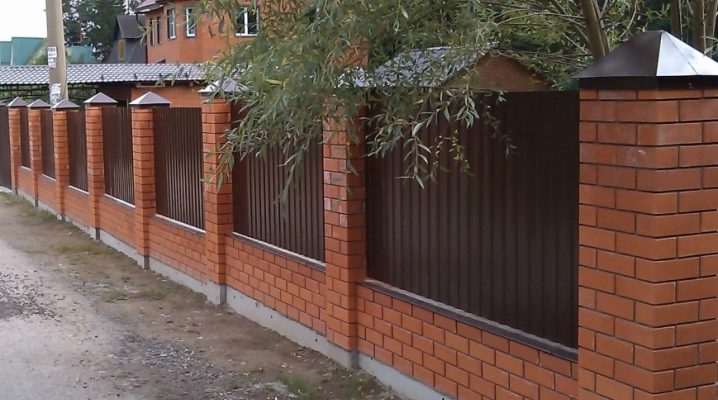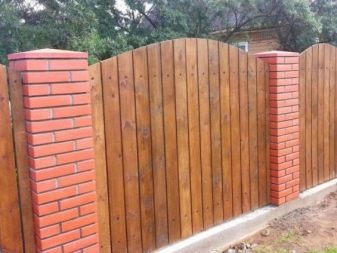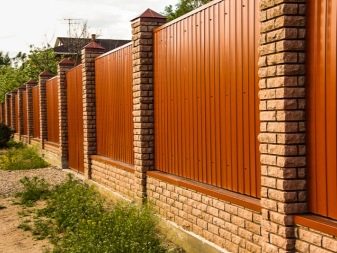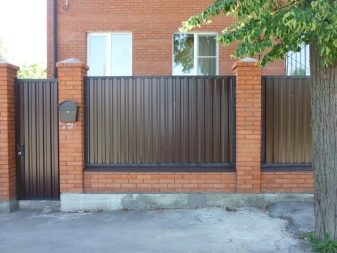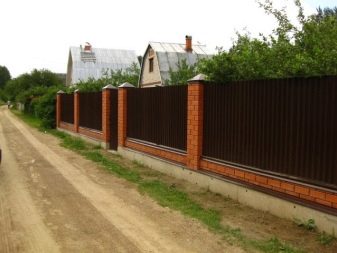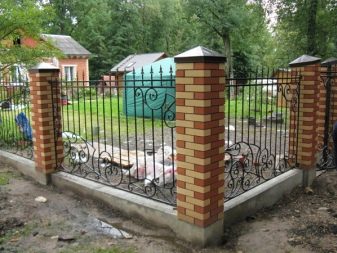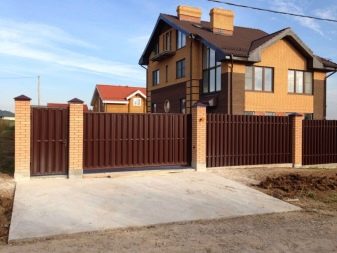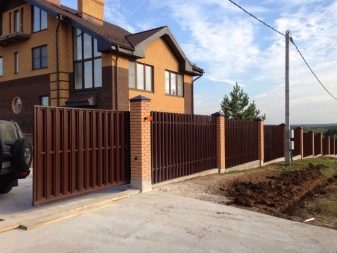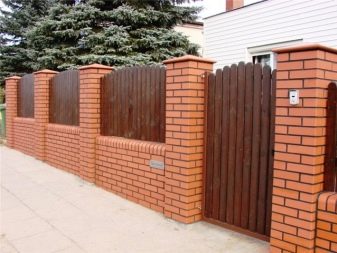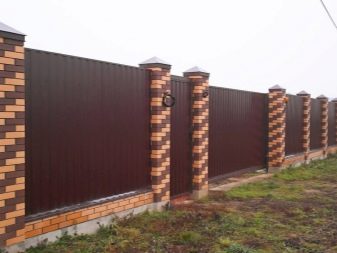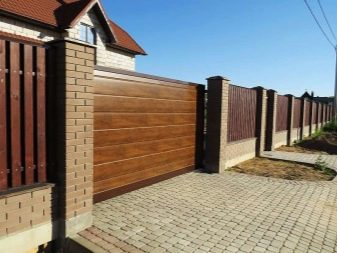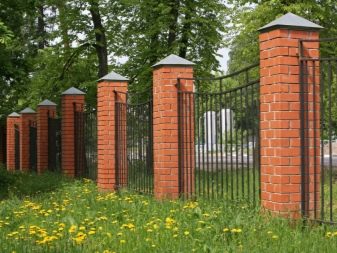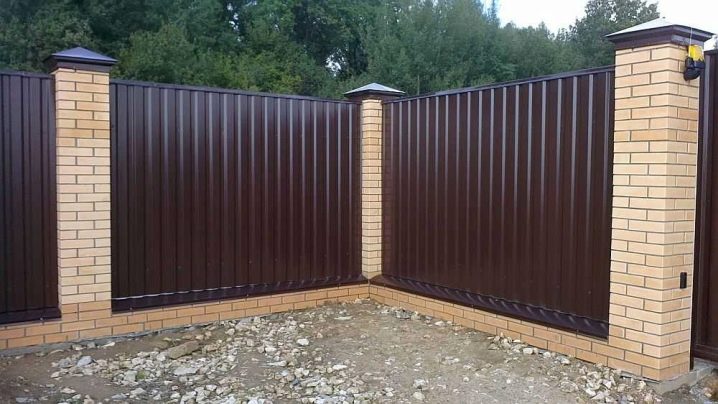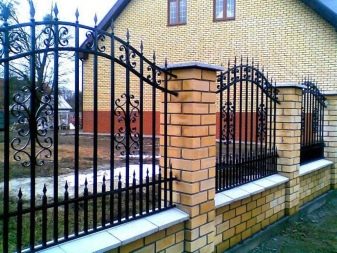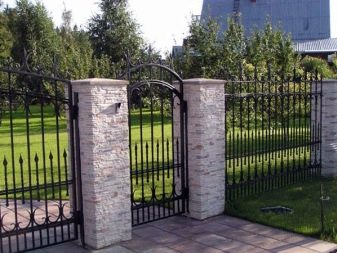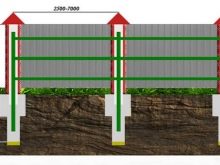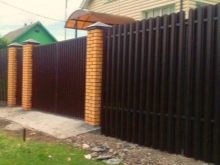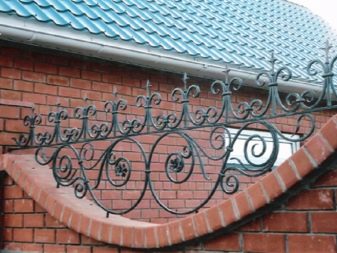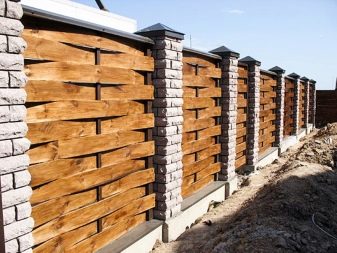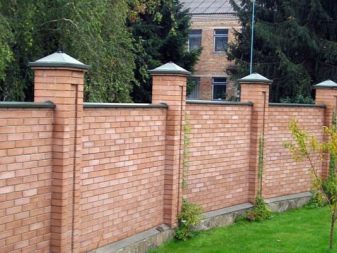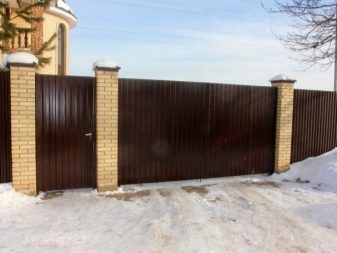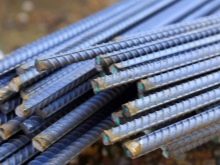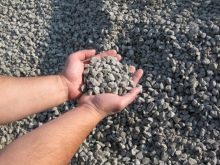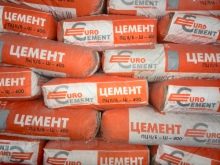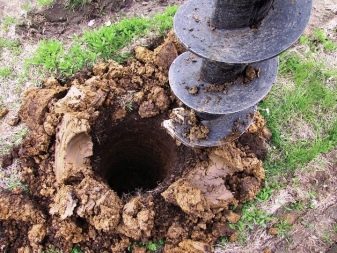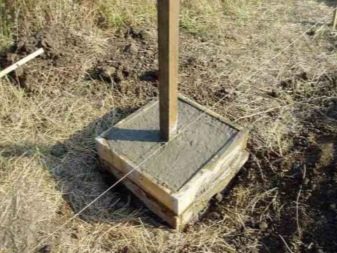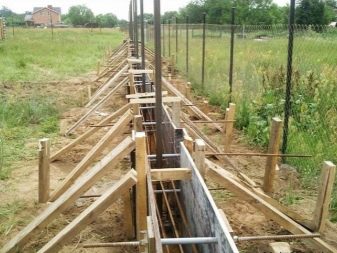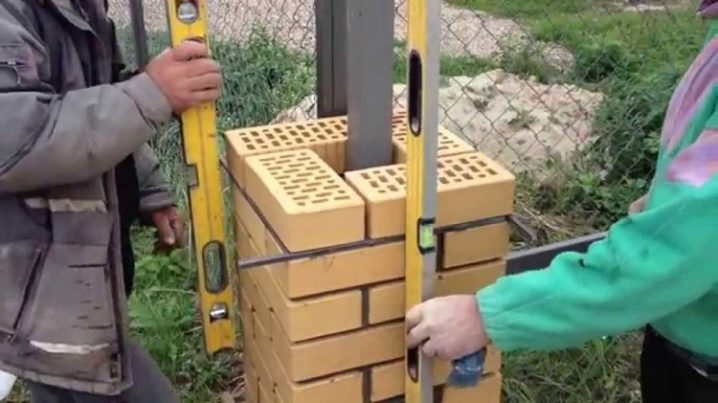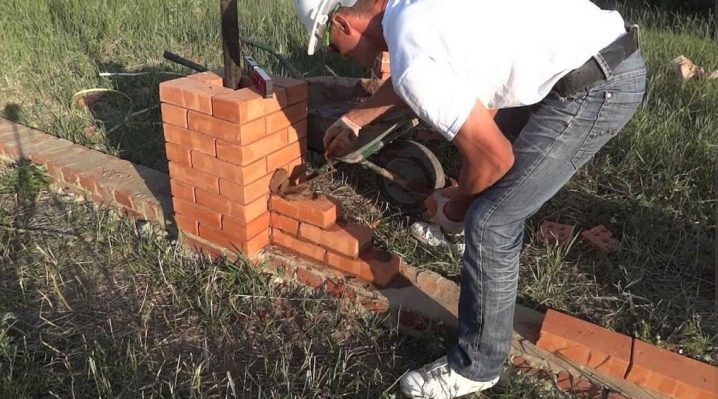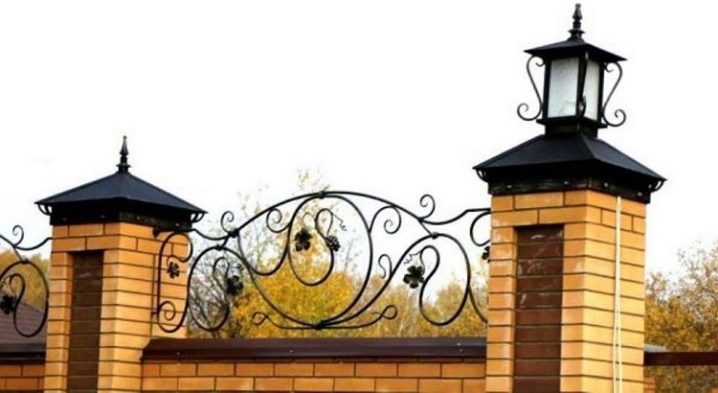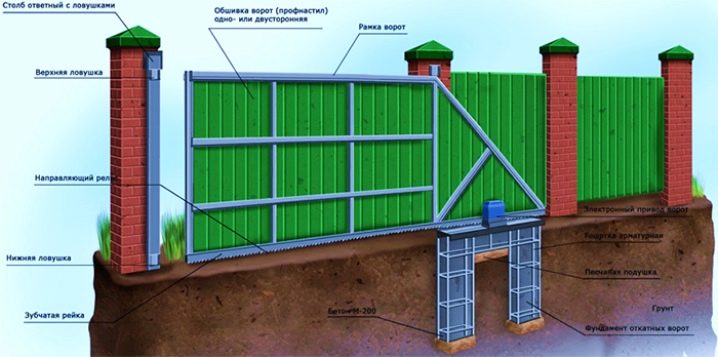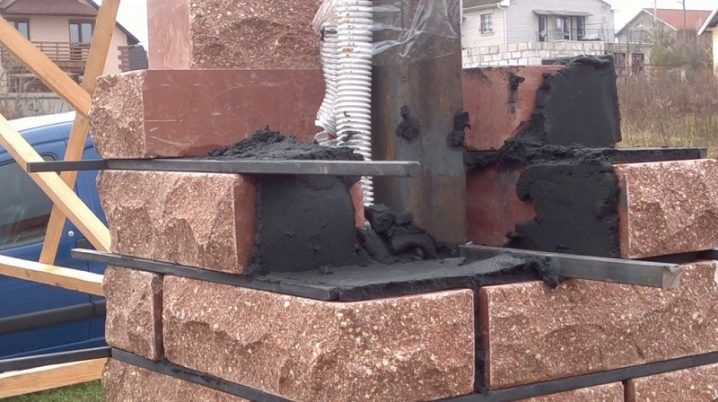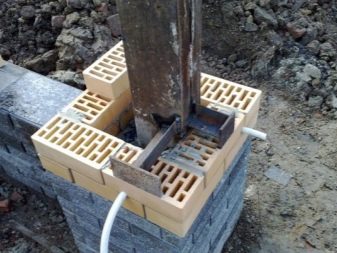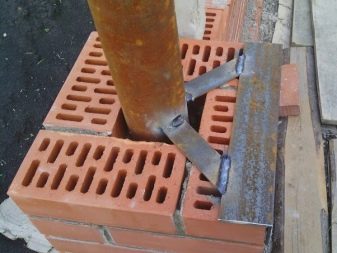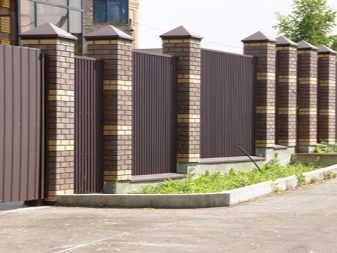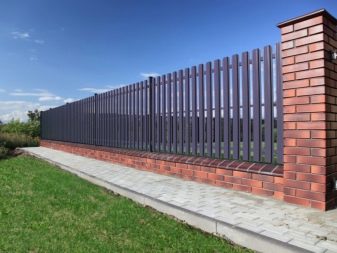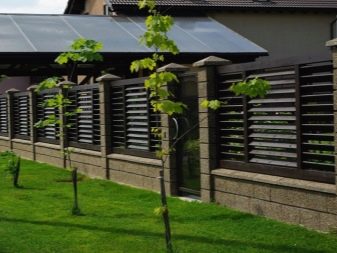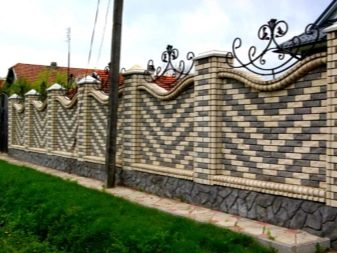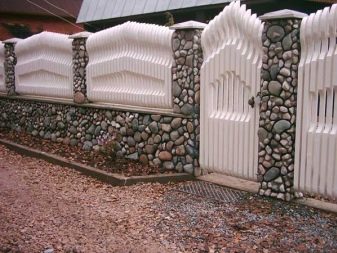Fence with brick pillars: beautiful decor options
Land is traditionally fenced. The fence is made of different materials. One option is a fence with a base of brick pillars with spans of corrugated, forged elements, wooden batten or brickwork. Such a fence looks solid, it reliably protects the territory and is decorated with its decoration.
The brickwork of the pillars is simple enough for independent production, if you become familiar with the technology of building such supports. Consider the details of this type of construction work.
Special features
The fence with brick pillars provides the necessary level of security from unwanted intrusions into the estate. The spans of corrugated or brickwork, reinforced on brick pillars, can add impermeability and reliability of the protective function of the fence.
Forged and wooden spans will give the exterior lightness of the structure, while maintaining the required level of isolation from the external environment.
Brick supports have durability and resistance to weathering. They are sufficiently resistant to increased payload for installing massive gates with an automatic sliding or mechanical swing device.
To extend the life of the pillars, they need to be covered with metal or concrete caps. Here it should be borne in mind that concrete caps have a greater variety of forms, but they themselves are destroyed by changes in temperature and humidity.
Metal caps better isolate the brickwork from moisture.
Fencing on brick pillars, providing an adequate level of protection, is more affordable than a fully brick fence. Types of bricks, pattern of masonry and material spans give a lot of room for decorative art in the design of such a fence. Brick pillars can be safely equipped with an electric cable to organize the lighting of individual pylons, which will be convenient for owners and serve as an additional decor.
Types of designs
To build a fence with brick supports, you need to decide on the type and height of the structure. The optimal height of the supports is selected about two meters, then the pillar is laid out 1.5 bricks wide, together with the seams it is 38 centimeters.
If necessary, you can increase the height to 3-4 meters, then laying is better to perform in two or more bricks. In this case, the size of the post will be about 50 to 50 centimeters. The width of the span has a range from 2.5 to 6 meters, the dimensions are selected according to the relief or the composition of the fence.
The type of foundation depends on the type of construction: tape or point. For spans of lighter materials under the columns of brick choose a point foundation, for heavy - tape.
Span from profiled sheeting - the most common option.
Benefits:
- Such a fence has an external conciseness and ease of installation.
- You can choose the desired color.
- With such spans caps of a geometrical form beautifully look.
- Convenient to mount the gate.
Under this type of fence make strip foundation. You can stay on the point supports, but the wear resistance and decorative qualities will be reduced.
For the fence with forged inserts, you can also apply the first and second versions of the supports. Of course, forging gives the fence artistic value and underlines the welfare of the owners. A strip foundation with several rows of bricks will add solidity to the fence. The airiness of the structure appears when the strip foundation is abandoned, but the functions of durability, reliable protection and decoration are preserved.
The next popular type of fences were spans of wooden and metal picket fence. It is also possible to use two types of foundation. The fence can be positioned both vertically and horizontally.
The fence can be completely laid out of brick or torn decorative stone, such fences are made on a reinforced foundation, they reliably isolate the territory of land tenure. For the decorative effect of the combined fences perform.
After selecting the type of fence, proceed to the selection of material.
Selection of materials
The material for the spans is chosen according to the degree of protection required: for the best insulation - a professional sheet or brick, for a decorative effect - metal forging, in rural farmstead a wooden or metal fence is well recommended as protection against cold winds and unwanted intrusions.
The fence material should be in harmony with the architecture of the outbuildings and the general concept of the site design. Classic mansions look harmonious with wrought or stone fences. It is better to fence the house in ethnic style with a wooden fence. In areas where there is poultry or other living creatures, solid fences of sheeting will be optimal.
In modern minimalist trends, it is better to use a fence with a minimum of decor. Simple and elegant. Such fences are decorated with spans of special glass or plastic.
Brick bollards are selected based on the overall design of the fence. For the first two or three rows, ordinary clay bricks will be required, then hollow or the same as in the bottom row will be used. To enhance the decorative effect, the columns are laid out with clinker bricks or facing bricks of the desired color in various combinations.
The embossed brick gives greater expressiveness to the architecture of the fence. Decorative trim can be applied only on the front side of the fence, and the inner leave in the form of a simple brickwork. This will give significant savings.
By the number of pillars, steel pipes are purchased, which will become a vertical axis for the reinforcement of brickwork. It should be borne in mind that in the columns for gates and wickets, the supporting fittings are purchased with a reinforced profile. Rebar will be required to strengthen the foundation, its quantity is calculated based on the need for a tape or point location.
You will need building fillers: cement, sand, crushed stone or expanded clay. It will be necessary to stock up on boards for the manufacture of formwork. Since the brick absorbs moisture very well, and when it freezes, it destroys the structure of the material, all brick structures will have to be protected from soil moisture, therefore, waterproofing material will be needed.
The calculation of the amount of necessary materials is made according to the length of the fence, the pitch of the brick supports and their size.
For a standard column of one and a half bricks with a height of 2 meters, 110 pieces of bricks are required.
Laying technology
Sequencing:
- The first step is to mark the contour of the fence using twine. Pegs are driven in in places of future supports. For the pile foundation, using a drill with the help of pegs, a hole is made 30-35 centimeters wide and 80 centimeters deep for sandy soil,and for clayey, up to a layer of freezing plus 20 centimeters.
In central Russia, it is best to maintain a depth of 1 meter or 1 meter 20 centimeters. A bucket of rubble is poured into this pit and tamped with it. According to the diameter of the pit, formwork is made; it is possible to roll a pipe of the required diameter from the roofing felt. A steel pipe is inserted into this formwork and is poured with a cement mixture.
A mixture of cement and sand is made in a ratio of 1: 5 or 1: 6, for plasticity you can add a little liquid soap. The solution should not be liquid or dry, so water is added gradually. The upper part of the foundation is poured into the formwork along the width of the pillar. For a strip foundation, a trench 50 cm deep and 40 cm wide is excavated between the pillars. The lower layer is reinforced with a cushion of rubble, a formwork of boards is installed along the trench and filled with mortar.
- After the foundation is poured, the masonry is started no earlier than in 2 weeks. The surface of the foundation is covered with waterproofing material so that the brick does not absorb moisture from the soil. Here you can apply roofing material, but more modern material is waterproofing on a bitumen basis.
- Embedded corners are welded to the steel pipe, the ears for the gates are welded, or the transverse pipes are welded to secure the material of the span - picket, professional sheet or forging.
- The next stage of work - brickwork. Here you need to carefully consider the quality of the solution, its density. For a sample, put some mortar on the brick, it should not spread. The bricks are laid according to the laying pattern with dressing through a row around a steel pipe. The first and second rows are stacked in the usual full brick, for the next you can use lightweight hollow cores.
- A layer of cement mortar with a thickness of 1 centimeter is applied to the waterproofing, and bricks are laid on this layer, each brick is tapped to be compacted with a rubber hammer. For even adhesion to the mortar, the brick is pre-dipped in water. It is better to measure each row with a tape measure, since a shift of even a few millimeters of each row can lead to a distortion of the pole or to an extension of several centimeters.
Each side should be regularly checked by level to avoid deviations from the vertical.
- If desired, you can make a decorative finish of the seams, usually add a dye or textured crumb to the cement mortar, and after finishing the laying, separate the seams with grease.This gives accuracy and completeness of the entire construction.
- After laying the entire post, the middle part around the pipe is filled with a solution, you can fill it with gravel and fill it with a more liquid solution. The top is again closed with a waterproofing layer.
- At the top of the structure reinforced cap of metal or concrete. Manufacturers offer a wide variety of shapes, colors and materials for the manufacture of such hubcaps. A simple rectangular cap can be made from a sheet of metal on its own pattern. The color is selected according to the color of the fence design.
- If the project provides for a combined masonry, then it is necessary to carefully choose the dimensions of the main and finishing bricks. If the brick pillar is finished with natural stone, then after the masonry has dried, the finishing layer is applied.
- The next stage consists in hanging the material of the span: profiled sheet, metal grill, picket fence, or laying out the span with a decorative brick.
- The final type of work is the installation of gates and wickets, installation of lighting.
Professional Tips
A few tips on making masonry will help you to do it well even for a beginner:
- To the seams between the rows of bricks were of the same thickness, a metal bar of the desired diameter is placed along the edge. Align the cement mortar on it, lay bricks on top, knock it with a rubber hammer, then take out the rod and lay it on the next row.
- To observe the perpendicularity of the corners, use a metal corner. Such a corner is fixed with screws to the seam and is transferred above several rows. The construction level must be applied to all sides of the pillar; it is better to have two levels and measure adjacent sides on them in order to avoid masonry twisting.
- For beginners it will not be easy to immediately achieve the required quality of brickwork, but after making one column, you need to take into account the mistakes and then the work will go faster. Laying out the columns yourself, you can save a lot and add more decorative details.
Beautiful options
For complex construction work, it is still better to invite professionals who have experience with a variety of decorative finishing materials. The presence of specialists is necessary to equip the fence with lighting and automatic gates.Here it is necessary to observe the safety regulations for laying electrical cables and organizing proper lighting. A beautiful and safe fence will ensure a calm flow of life within the plot.
To perform a stone fence with metal inserts at a decent level will help special skills and experience.
It looks modern horizontal picket fence, matched to the tone of the main buildings of the estate.
The wrought-iron fence overgrown with a green liana looks very beautiful.
The twisted structure of a brick pillar turns such supports into the decoration of the plot.
Brick pillars, trimmed with round stone with white spans, are stylish and elegant fencing.
To learn how to make a fence of brick columns and a professional sheet, you can find out by watching the video below.
